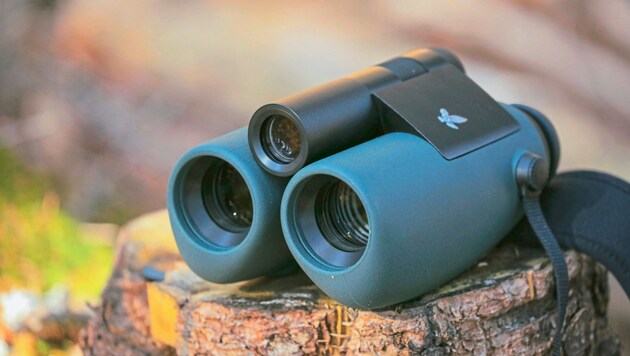The hawk and AI
Swarovski binoculars recognize bird and animal species
Georg Blatnig is the developer of the new Swarovski AX Visio, the first binoculars with integrated animal and bird recognition. Blatnig tells the "Bergkrone" how the technology behind it works and for whom the new high-end binoculars are suitable.
When it comes to binoculars, nobody in the world can beat the Tyroleans. The iconic binoculars from Wattens have been coveted for generations and are known for their optical excellence. Swarovski's binoculars with the iconic Habicht logo are often even passed down from generation to generation. Founded in 1949 by Wilhelm Swarovski, the company is entering completely new territory with the elegant Swarovski AX Visio, in which the Tyroleans have integrated a smartphone into a pair of classic Swarovski EL10x32 binoculars.
"We wanted to supplement our optical capabilities with digital functions," says developer Georg Blatnig in an interview with "Bergkrone". Sounds really cool, and according to Blatnig, the media and customer feedback was also "mega" when the product was presented in January at CES in Las Vegas, the world's largest trade fair for consumer electronics.
The smart "Swaro" is designed to recognize 9000 (!) bird and mammal species at the touch of a button. And right up front: the bullfinch currently building its nest in front of the office window in the "Krone" editorial office is promptly recognized as a "bullfinch". The AI-supported binoculars cost 4600 euros.
Five years of development work went into the AX Visio. A camera lens sits in the middle of the binoculars. "A 13-megapixel camera with a focal length of 270 millimetres is installed," explains Blatnig. The camera is not only necessary to be able to photograph or film what is being observed, but primarily for image recognition. Blatnig: "The camera provides good images for documentary purposes and for sharing."
For image recognition, the Tyroleans are working together with Cornell University in the US, which is known for its ornithology laboratory and which has developed the "Merlin Bird ID" app, which in turn is based on eBird, the world's largest database for bird sightings.
Blatnig: "If you want to identify a bird, a detection algorithm checks whether the bird is large enough and whether enough details are recognizable to compare them with the integrated database." Each time a bird is identified, the binoculars take a photo and store it in the 28 gigabyte internal memory along with other information such as the bird's name, GPS coordinates, time, date and other information. The photos and videos taken can be transferred to the smartphone via Bluetooth. To do this, you must first install the accompanying "Swarovski Optik Outdoor" app on your smartphone.
Swarovski promises regular updates for the AX Visio, which should make bird and animal detection ever more reliable in line with Swarovski's guiding principle of "constantly improving the good". Because that's exactly where the problem lies. A few branches between the hooded crows and the observer are enough to cause AX Visio to stumble, misidentify birds or fail to recognize them as "Bird not recognized". The house sparrow in the bush suddenly becomes a dunnock. If the animals are too far away, recognition will not work either. The closer, the better. You need to be 20 to 30 meters away from songbirds to get a good result.
"Unfortunately, we can't guarantee 100% certainty when it comes to detection, but we are constantly developing the system and training the database," says the developer, who regularly goes birding in the great outdoors himself.
In addition to bird and mammal detection, which can be selected using the function wheel, there are also camera, compass and inclinometer functions, live view to share the camera image with up to five people via livestream using the app and marking. This allows you to mark an observation and then hand the binoculars to a person who then guides you to the marked observation using arrows.
What is really annoying, however, is that the smart binoculars take almost half a minute to boot up and be ready for use. Blatnig explains the long start-up time by the fact that the binoculars also contain a GPS module, as there are many birds in Europe and North America that are very similar, but live on different continents. "When I go birdwatching, I switch the device on in the car, so it's ready to use as soon as I set off." With maximum use, i.e. connected to a smartphone and live streaming, the battery lasts between four and five hours, with normal use it should be up to 15 hours.
And if the smart binoculars do run out of power, the Swarovski AX Visio can at least be used as normal binoculars. "The optical quality is the same as our EL 10x32 binoculars," says Blatnig. And anyone who owns Swarovski binoculars will appreciate this - with or without AI bird and animal recognition.
















Kommentare
Willkommen in unserer Community! Eingehende Beiträge werden geprüft und anschließend veröffentlicht. Bitte achten Sie auf Einhaltung unserer Netiquette und AGB. Für ausführliche Diskussionen steht Ihnen ebenso das krone.at-Forum zur Verfügung. Hier können Sie das Community-Team via unserer Melde- und Abhilfestelle kontaktieren.
User-Beiträge geben nicht notwendigerweise die Meinung des Betreibers/der Redaktion bzw. von Krone Multimedia (KMM) wieder. In diesem Sinne distanziert sich die Redaktion/der Betreiber von den Inhalten in diesem Diskussionsforum. KMM behält sich insbesondere vor, gegen geltendes Recht verstoßende, den guten Sitten oder der Netiquette widersprechende bzw. dem Ansehen von KMM zuwiderlaufende Beiträge zu löschen, diesbezüglichen Schadenersatz gegenüber dem betreffenden User geltend zu machen, die Nutzer-Daten zu Zwecken der Rechtsverfolgung zu verwenden und strafrechtlich relevante Beiträge zur Anzeige zu bringen (siehe auch AGB). Hier können Sie das Community-Team via unserer Melde- und Abhilfestelle kontaktieren.